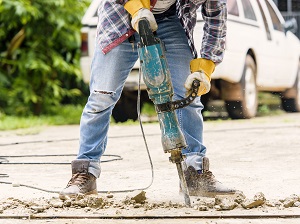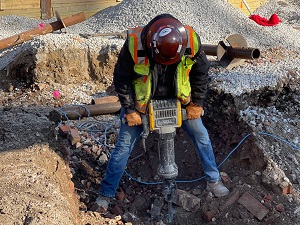If safety precautions are not taken seriously, jackhammers and handheld powered chipping tools can be dangerous. Jackhammer operators on the job site must be trained and authorized.

The major safety risks to be aware of when operating a jackhammer include:
- flying debris
- fatigue
- sprains and strains
- abrasions and lacerations
- harmful vibrations
- respiratory hazards
- hazardous noise exposure
- electrocution
OSHA Standard 1926.300(a) All hand and power tools and similar equipment, whether furnished by the employer or the employee, shall be maintained in a safe condition.
Jackhammer operators, and those working in the area, should be wearing appropriate personal protective equipment (PPE) including hearing protection, safety glasses, and steel-toed boots. Jackhammer operators should also be wearing gloves and metatarsal guards.
In areas where the exact location of underground electrical power lines is unknown, jackhammer operators must wear insulating gloves.

Jackhammers can be very heavy so always get help with loading and unloading. When the jackhammer is still on the job but not currently in use, lay the jackhammer down, instead of propping it up. This will prevent the tool from falling over which can cause an injury.
Check that air hose couplings are secure before each use. Stretch out the air hose and place it where it will not cause a tripping hazard.
Always make sure to use the right bit for the job.
Operators should use their upper body strength and their legs to lift on the jackhammer, not their back. Feet should be planted shoulder-width apart with the body square to the jackhammer. If the jackhammer is to be used for periods of greater than 15 minutes, workers should rotate the task to minimize chances of injury.

Using a jackhammer or handheld power chipping tool to break or demolish concrete, stone, masonry, or other silica-containing materials can generate respirable crystalline silica dust. When inhaled over time, the small particles of silica can irreversibly damage the lungs.
Two methods for controlling dust when using jackhammers or powered chipping tools are:
Wet Methods. Use a manual sprayer or water-spray system that provides a continuous stream or spray of water at the point where the jackhammer’s tip strikes the surface material.
Vacuum Dust Collection System (VDCS). A shroud around the jackhammer connects to a vacuum that provides enough suction at the cutting point to effectively capture the dust.
OSHA Standard 1926.1153(c)(2)(ii) For tasks performed using wet methods, apply water at flow rates sufficient to minimize release of visible dust.
Where water is used to control dust, electrical safety is a concern. Use ground-fault circuit interrupters (GFCIs) and watertight, sealable electrical connectors for electric tools and equipment.
In addition to using wet methods or a VDCS, the use of respiratory protection with a minimum Assigned Protection Factor (APF) of 10 is required whenever jackhammers or handheld powered chipping tools are used indoors or in an enclosed area. APF 10 respirators are also required when jackhammers or handheld powered chipping tools are used outdoors for more than 4 hours per shift.

When jackhammers or chipping tools are used indoors or in an enclosed area, wet methods or a VDCS may not reliably keep exposure low. Extra ventilation may be needed to reduce visible airborne dust. Extra ventilation can be supplied by using exhaust trunks, portable exhaust fans, air ducts, or other means of mechanical ventilation.
Position the ventilation to move contaminated air away from the workers’ breathing zones. Ensure that air flow is not impeded by the movements of workers, or by the opening or closing of doors and windows.
OSHA Standard 1926.1153(c)(2)(i) For tasks performed indoors or in enclosed areas, the employer shall provide a means of exhaust as needed to minimize the accumulation of visible airborne dust.
Unless there is a ventilation system that effectively captures the dust cloud, do not use compressed air or blowers to clean surfaces, clothing, or filters because it can increase exposure to silica. Instead, clean with a HEPA filter-equipped vacuum or by wet methods.


.jpg)
